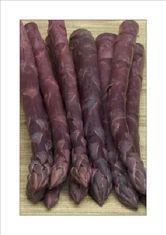
Managing the carbohydrate (CHO) levels in the asparagus crown is fundamental to maintaining a good yield the subsequent year. Now, thanks to the internet delivered AspireUK system, British growers have a valuable computer-based decision support system to help improve production by measuring and interpreting root carbohydrate content.
Painstakingly developed by the New Zealand Institute of Crop & Food Research, the system helps growers make informed decisions to optimise the sustainability of crops by ensuring the best balance between short and long-term performance and economic life. Through collaboration with the Horticultural Development Council, ADAS and Hargreaves Plants, the system has been fine-tuned to UK conditions and varieties and is now commercially available.
Asparagus might be a minority vegetable, but sales are increasing at a healthy rate. Historically in the hands of traditional small to medium-scale growers, over the last decade a number of larger vegetable and potato growers have entered the arena, gearing up supply to the multiples.
Although a year round vegetable, UK asparagus consumption still peaks in our traditional season from May 1 to June 21. Historically, harvesting has stopped three weeks in to June to allow the asparagus fern to grow through the summer months and transfer its carbohydrates to the crown.
In a bid to improve continuity and returns, UK growers are looking to extend the season in both directions. Harvesting of the first spears can be brought forward through varietal selection, planting further south, using south facing slopes and or raised beds and black plastic. Conversely the season can be extended through growing later varieties, growing in colder parts of the UK on north facing slopes and by having the confidence to carry on harvesting beyond the traditional June 21 cut off point.
Aspire is the culmination of a project that began with extensive sampling of asparagus root systems at Lincoln, New Zealand. Interpreting the results, crop physiologist Derek Wilson and his team built up a clear picture of what is going on under ground - namely that spear and fern growth above the ground is accompanied by a characteristic pattern of carbohydrate depletion and accumulation in the roots.
Using the analogy of a car, Derek Wilson explained that the asparagus root system is the engine driving crop performance. “The size of the root system equate to the capacity of the fuel tank,” he said. “The CHO content of the root indicates how full, or empty, the tank is at any time. Knowing how much fuel there is in the tank helps growers make better crop management decisions.”
Aspire is the equivalent of the fuel gauge - it measures and interprets root CHO content and identifies deviations from the ideal CHO pattern. The system also provides advice on how to interpret the information to guide management decisions aimed at achieving the best balance between short and long-term performance.
The root CHO levels are assessed by collecting root samples and measuring brix percentage values. With a lot of inherent variability in any crop, Derek Wilson recommends taking 20 root samples.
Samples are washed, frozen, thawed and squeezed through a garlic press to obtain sap. The Brix percentage is measured using a refactometer and the data entered in to Aspire. The data is converted in to CHO content and compared to performance benchmarks to produce an immediate on-line response. The system also generates comments about condition of crop and recommendations to optimise performance.
Aspire also acts as a database storing information creating a record of each crop’s performance. The data can be retrieved at any time to evaluate the effects of management decisions on the crops performance.



